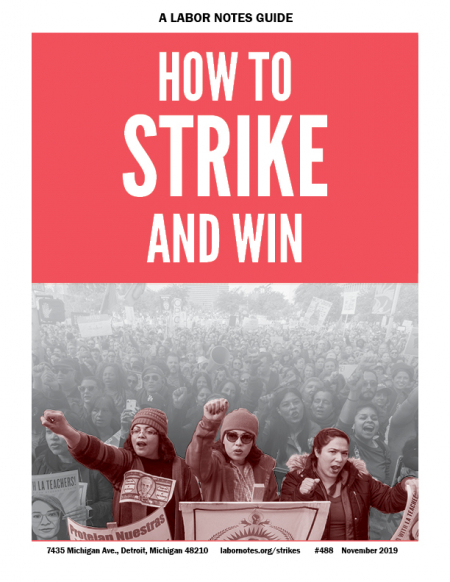Organize the Organized

A strong contract campaign requires a robust person-to-person communication network. Photo: Richard Becker.
You'll need an action team, and a communications network so information zips around fast.
How to Strike and Win
A Labor Notes Guide
labornotes.org/strikes
The Big Picture
Know Your ABC's
Building Blocks
- Turn Up the Heat
- Organize the Organized
- Democracy: Who Owns the Strike?
- Community: Who Else Owns It?
- How to End a Strike
At a Glance
Organizing for a strike requires a whole lot of one-on-one conversations. How will you invite and persuade your co-workers to join the escalating campaign actions described here?
You will be asking co-workers to take a series of increasing risks, culminating in a big one that could, in the worst case, cost them their jobs. Making this ask in a newsletter or a Facebook post, no matter how eloquent, isn’t going to cut it.
A strong contract campaign requires a robust person-to-person communication network. Its backbone is a layer of members who are deeply involved, often called the Contract Action Team. Your CAT shouldn’t be the same people as your core bargaining team—because you’ll need someone out organizing while the bargainers are stuck in a room.
IDENTIFY LEADERS AND RECRUIT THEM
To be effective, a CAT has to be made up of enough people—aim for one CAT member per 10 workers, and one from every work area and shift. And they have to be the right people—those whom others trust and respect. Collectively, your committee should have the ear of the entire workforce.
At the Pennsylvania grocery chain Giant Eagle, the union looked for leaders in the lunchroom. “We tried to keep an eye out on who was the one at the lunch table that had a lot of people talking to them or stopping by,” said Tina Shreckengost, a shop steward in UFCW Local 23. “They are the ones that are more likely to communicate with everyone.”
To identify leaders from each department and shift, upstate New York hospital workers in CWA Locals 1133 and 1168 asked these questions:
- Who do people go to when there’s a problem?
- Who’s the contract expert?
- Who isn’t afraid to share their opinions and ideas with co-workers?
- Who isn’t afraid to approach management with concerns?
These leaders became department mobilizers, who met every two weeks to debrief, hear the latest updates from bargaining, ask questions, and let each other know what rumors were going around. They didn't end up going on strike, but won a contract that reversed previous givebacks—because they had built a credible strike threat.
The high ratio of activists to members makes the load manageable. It creates an opportunity for more people to get involved. And it makes the group nimble enough that information can be quickly distributed and collected.
Each action is a test of your organizing network. (See here.) CAT members should routinely report participation back to union headquarters. In areas where the numbers are low, the union should help, usually by either recruiting additional leaders or offering more support to the existing CAT activists.
BOX:
WHAT THE CONTRACT ACTION TEAM DOES
Divide up your member list among the CATs, so each one takes charge of keeping about 10 co-workers in the loop. That means they will:
- Update co-workers about bargaining progress.
- Solicit feedback and ideas.
- Explain the campaign plan.
- Ask co-workers to join actions.
- Talk them through their fears.
- Distribute flyers and buttons.
- Set up department meetings.
- Track who participates.
- Inoculate against the employer’s tactics.
- Keep an up-to-date contact list, including cell phone numbers and email addresses, and any new hires.
- Keep in close touch with union headquarters—information should flow in both directions.
CAT members aren’t just drones carrying out orders. They’re a team of activists at the heart of the campaign, who should have a real say in the plan. The CAT should meet regularly to troubleshoot and help devise next steps, in coordination with whoever else does those things—likely the union’s elected officers, bargaining team, and senior staff.

SUPPORT LABOR NOTES
BECOME A MONTHLY DONOR
Give $10 a month or more and get our "Fight the Boss, Build the Union" T-shirt.
At the outset and during the campaign, CAT members should get relevant training, such as how to have a good organizing conversation and how to armor members against the employer’s scare tactics.
DON'T HOARD POWER
The 1:10 ratio sounded pie in the sky to some longtime activists in United Teachers Los Angeles, when the union was in the early stages of its latest contract campaign.
“At the beginning people didn’t really believe that they could get that many people to step up in their school,” said Gillian Russom, a history teacher and UTLA board member. “People said it was too much work and would never happen.”
The established way of doing things in many unions is to rely on a few heroic activists who do all the work. A longtimer who is used to fighting solo might bemoan this situation, yet still feel a tinge of reluctance about sharing power with some johnny-come-lately. Resist this impulse!
“We have amazing activists who have been involved in fights for decades, and they are great,” said UTLA activist Erika Jones, an area chair who helped develop the CATs in many schools. “But it’s important to build a team at the worksite—people to help pass out flyers, or think through actions, or help put things on the bulletin board.”
BEYOND THE CAT
In a strike there are important roles for everyone, not just the CAT members. You’ll need various committees as well as people to make signs and photocopies, haul supplies, buy snacks, compose chants, lead songs, and much more. See “Strike Prep” here.
ROLL THE UNION ON
However your strike turns out—or even if you avert a strike at the last minute—your union will emerge much better off for having built up member teams.
Organizing a contract campaign gives new and seasoned activists the opportunity to learn new organizing skills and reinforce old ones. It uncovers new leaders and brings more people into the life of the union.
Member teams center the union where it gets its strength: the workplace. Don’t let your new networks wither away afterward. Too often, union leaders look at member activity as a switch to be turned on at contract time—and off once a contract is won.
Instead, a union should keep its communication network active and immediately available. Convert your Contract Action Team into a Member Action Team. Put it up on a wall chart or track it in a spreadsheet. Continually check to make sure no members have dropped out, and replace them if they have. Use it to organize mini-campaigns on issues in between contracts.
For more on organizing at the end of the strike and afterwards, see here.
BOX:
WHAT PICKET CAPTAINS DO
During the strike itself, CAT leaders can become picket captains and organizers, responsible for worksites, shifts, or departments. They’ve already built the relationships, and their roles on the picket lines are largely the same—talking with everyone, involving everyone, taking attendance, making assessments, and reporting in.
Picket captains should:
- Sign members in at the beginning of picket shifts, and contact those who don’t show up.
- Report attendance to headquarters. United Teachers Los Angeles created an app that picket captains could log into and update each morning, so that the union had a live breakdown of how strong the lines were in real time—and could send help to lines that needed support.
- Send updates to headquarters about what’s happening on the ground.
- Know the legalities and what rules the union has decided to follow in its pickets and protests.
- React to unexpected developments or emergencies, or if the press or police show up.
- Keep up the energy on the line.
Your communication network becomes the basis of a flexible structure that allows for quick action. During the 2016 Verizon strike, CWA Local 1101 in New York City had some picket teams based on site and some mobile ones that could be sent wherever needed. When the union found out that the company was dispatching scabs from a vehicle rental site, the mobile teams threw up a picket line at the gate. When reports came in of managers working in the field, these teams hopped into cars and chased them down— keeping the managers out of manholes and off telephone poles.
When the union got word that scabs were being housed in hotels, picket captains activated their phone tree, turning out hundreds of members for early-morning “wake-up calls” that booted out the scabs (see here).
“One of the lessons from the 2016 strike: the company adapted,” said field technician Pam Galpern, a mobilization coordinator for the local. “We put plans in place beforehand, but we had to be flexible. If we had just held big picket lines at the garages, it would have been ineffective.”







You must log in or register to post a comment.